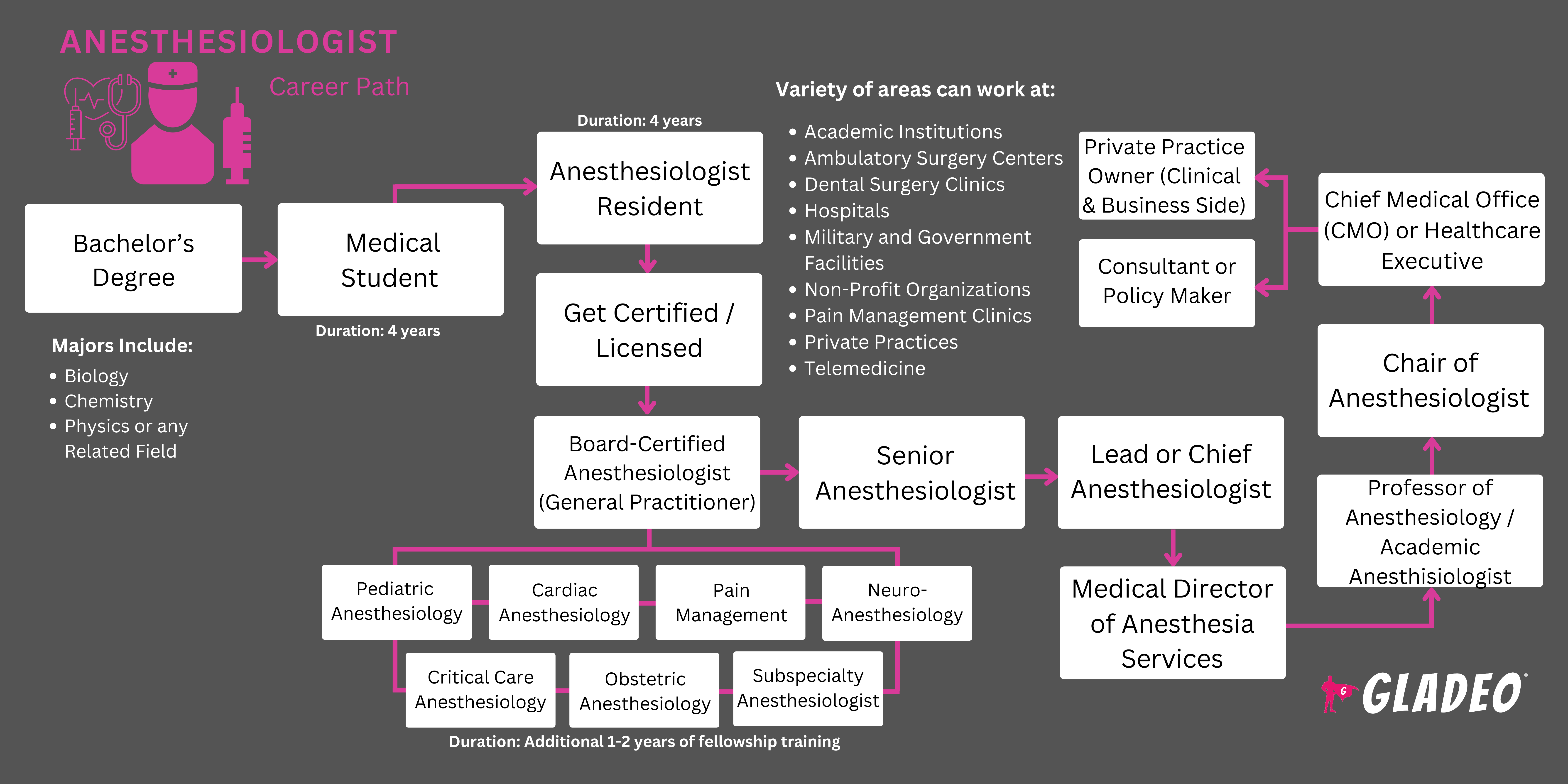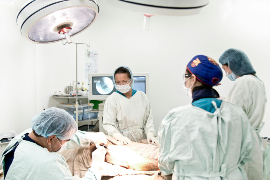Focos
Medical Doctor (MD), Obstetrical Anesthesiologist, Staff Anesthesiologist, Staff Anesthetist
Surgery and other medical procedures often require the use of anesthesia to ensure patients are as comfortable and pain-free as possible. Administering anesthesia is complex and often demands the skills of highly trained Anesthesiologists – doctors specializing in anesthesia care, pain management, and critical care medicine.
Anesthesiologists may work in various settings, including operating rooms, ICUs (Intensive Care Units), emergency rooms, and labor and delivery. They review patient medical histories, develop customized anesthesia administration plans, and monitor patient vital signs such as heart rate, blood pressure, and breathing during procedures. They also follow up after procedures to ensure no unexpected side effects.
Anesthesia procedures range from putting patients completely under to pain-blocking measures that don’t impact the patient’s consciousness, but they all carry certain risks that must be carefully considered and managed. That is why Anesthesiologists are considered perioperative physicians – doctors who manage patient care before, during, and after surgery to ensure optimal outcomes!
- Direct impact on patient comfort and safety during surgeries and other medical procedures
- Opportunity to work in a highly respected and specialized medical field
- Options for multiple subspecialties
- High job stability and demand in various healthcare settings
- Excellent pay and benefits
Tareas típicas
- Thoroughly review patient health history before any type of anesthesia administration. Ask questions or conduct physical exams, as needed.
- Take extra precautions for at-risk patients such as the elderly, diabetics, those with lung or kidney disease, smokers, persons with sleep apnea, etc.
- Provide care for patients in critical condition, such as those in intensive care units (ICUs).
- Create a tailored anesthetic plan, with calculated dosages suitable for each circumstance. Plans may include local, regional, or general anesthesia, as well as sedation.
- Evaluate patients in person during procedure preparation to assess potential risks.
- Ensure patients have followed proper pre-operative instructions, such as not eating or drinking for a certain amount of time or avoiding certain medications.
- Collaborate with surgeons, nurses, technicians, and other healthcare team members.
- Prepare and administer anesthetic drugs to induce loss of sensation or consciousness.
- Administer anti-nausea medication, as needed.
- Monitor patient vital signs such as blood pressure, oxygen level, and heart rate before, during, and after anesthesia.
- Look for signs of allergic or other negative reactions. Adjust anesthetic levels as needed to maintain stable conditions.
- Discuss possible side effects, recovery times, and ways to manage pain after procedures. Prescribe pain medications.
Responsabilidades adicionales
- Answer questions from patients, family members, or caretakers.
- Review special considerations such as patients who may need to breastfeed babies.
- Supervise nurse anesthetists, assistants, and other staff.
- Maintain detailed records of anesthesia care.
- Ensure sufficient inventory supplies have been ordered and all equipment has been properly cleaned or sterilized by staff.
- Monitor patient airways during intubation/ventilation. Monitor IV fluids, blood, plasma, and other fluids.
- Aid in emergency life-sustaining care, if necessary.
Habilidades sociales
- Escucha activa
- Atención al detalle
- Trato en la cama
- Calmness
- Comunicación
- Compasión
- Compostura
- Pensamiento crítico
- Decisión
- Fiabilidad
- Orientación al detalle
- Dexterity
- Diligence
- Empatía
- Hand-eye coordination
- Integridad
- Methodical
- Monitoring
- Observador
- Paciente
- Resolución de problemas
- Creación de relaciones
- Seguridad
- Buen juicio
- Stamina
- Stress management
- Gestión del tiempo
Competencias técnicas
- Advanced patient-controlled analgesia devices and automated drug delivery systems
- Advanced ultrasound techniques for regional anesthesia and vascular access
- Airway management, intravenous (IV) access, and life support procedures
- Anesthesia information management systems
- Anesthetic techniques, including general, regional, and local anesthesia
- Medical software and electronic medical records systems, such as: Allscripts PM, Bizmatics PrognoCIS EMR, CareCloud Central, eClinicalWorks EHR software, GalacTek ECLIPSE, GE Healthcare Centricity Practice Solution, IOS Health Systems Medios EHR, McKesson Practice Plus, WRSHealth EMR, etc.
- Monitoring equipment (e.g., ventilators, electrocardiograms) and interpreting vital signs
- Point-of-care testing devices for rapid diagnostics
- Robotic-assisted surgical systems in anesthesia care
- Simulation technology for anesthetic scenarios
- Telemedicine platforms for remote patient monitoring
- Ambulatory surgery centers
- Academic and research institutions
- Dental surgery clinics
- Hospitals (surgical units, emergency rooms, intensive care units, labor and delivery wards), including military facilities
- Pain management clinics
- Specialized medical practices (cardiology, orthopedics, etc.)
Anesthesiologists work full-time and some have irregular hours including night shifts, weekends, or holidays. The unpredictable nature of surgeries and emergency procedures requires a lot of flexibility, therefore personal schedules may be interrupted. They might be “on call” even when they’re not at work, meaning they must be available in case of emergencies.
Anesthesiologists often work with patients going through the most critical, high-risk moments of their lives. Providing care in such situations can be stressful and emotional, long after the procedure is done. That’s why Anesthesiologists must remain calm, composed, and focused. Being able to show empathy and make decisions under pressure is vital. There are also physical risks like potential exposure to diseases, bodily fluids, and hazardous materials. Thus, strict safety protocols are always required.
Anesthesiology is evolving with technologies such as advanced monitoring equipment and sensors that can detect complications earlier and allow for more precise anesthesia. AI is also helping predict patient responses, enabling more personalized anesthesia plans
There’s also a shift towards non-opioid pain management, using techniques like regional anesthesia, nerve blocks, and multimodal analgesia to reduce side effects and risk of addiction. Meanwhile, the rise of minimally invasive surgeries is requiring Anesthesiologists to adapt to shorter procedures while maintaining effective pain control.
Anesthesiologists might have been excellent students who enjoyed helping people and were able to stay calm under pressure. They may have grown up with a keen interest in biology or medicine, too.
- Anesthesiologists are medical doctors, so they have extensive education and training requirements. These begin with a bachelor’s degree focused on pre-med coursework.
- Bachelor's degree majors vary, but popular pre-med majors include biology, chemistry, and biochemistry. These majors can help students meet medical school prerequisites.
- Common undergrad courses may include anatomy and physiology, biochemistry, biology, biology labs, calculus, genetics, and organic chemistry.
Medical School
- Medical schools provide education and training for future Medical Doctors (MDs) or Doctors of Osteopathic Medicine (DOs) through rigorous coursework, clinical rotations, and hands-on experience.
- Note that anesthesiologists can be either MDs or DOs.
- Medical schools must be accredited by the Liaison Committee on Medical Education for MD programs or the Commission on Osteopathic College Accreditation for DO programs.
- Medical school programs consist of two phases – a preclinical phase featuring courses, labs, activities, and skills
development; and a clinical phase involving supervised patient consultations at clinics or hospitals. - Medical school applicants must pass the Medical College Admission Test (MCAT) and submit results along with their program applications.
- The MCAT is a multiple-choice exam designed to assess “problem-solving, critical thinking, and knowledge of natural, behavioral, and social science concepts and principles prerequisite to the study of medicine.”
- When assessing applications, medical school review boards consider applicants’ undergraduate coursework, GPA, and MCAT scores, as well as demonstrated leadership traits and extracurricular activities. The review officers conduct formal interviews of selected candidates.
- Additional factors that review boards may consider include:
- Clinical experience: Hands-on experience in a healthcare setting, such as shadowing doctors or volunteering in hospitals.
- Letters of recommendation: Strong recommendations from professors, healthcare professionals, or mentors.
- Research experience: Involvement in medical or scientific research, showcasing analytical and problem-solving skills.
- Personal statement: A compelling essay highlighting the applicant’s motivation for pursuing medicine, unique experiences, and character.
- Diversity of experiences: Life experiences, cultural background, or unique perspectives that contribute to a well-rounded applicant pool.
- Community service: Demonstrating commitment to serving others, particularly in underserved or disadvantaged communities.
- Resilience and grit: Evidence of overcoming challenges or adversity, reflecting determination and perseverance.
- Ethical judgment and professionalism: Clear examples of sound ethical decisions and maturity.
Licensure and Residency
- Medical school graduates must complete a ~4-year residency program at a clinic or hospital to develop deeper knowledge and hands-on experience.
- After the first year of residency internship, physicians should apply for state licensure, with requirements differing from state to state. MDs must pass steps 1 and 2 of the U.S. Medical Licensing Examination (USMLE). DOs must pass levels 1 and 2 of the Comprehensive Osteopathic Medical Licensing Examination (COMLEX-USA).
- In addition, doctors must complete either core clerkships or additional periods of clinical instruction.
Fellowships
- Anesthesiologists who select a subspecialty must undergo additional training via a 1- or 2-year fellowship. Options include:
- Cardiac Anesthesia – for heart surgeries and related procedures.
- Critical Care Anesthesia – for critically ill patients in intensive care units.
- Neuroanesthesia – for brain and spinal surgeries.
- Obstetric Anesthesia – for pain relief and anesthesia during childbirth.
- Pain Medicine – for acute and chronic pain.
- Pediatric Anesthesia – for infants, children, and adolescents.
- Regional Anesthesia – for nerve blocks and specific regions of the body.
Board Certification
- Board certification is done through the American Board of Anesthesiology and requires passing written and oral exams.
- Note that anesthesiologists must engage in ongoing professional development and continuing education to maintain certification and stay current with advancements in the field.
- For undergraduate schools, look for programs that are accredited and feature the rigorous foundational coursework you’ll need to succeed at med school. Medical schools are tough to get into, so you need to be well-prepared! That includes knocking out your bachelor’s in a relevant major while maintaining a strong GPA.
- Schools often post minimum GPA conditions for applicants, but keep in mind that meeting the minimum won’t make an application competitive.
- Many schools serve as “feeder schools” for popular medical schools. It’s not required to attend a feeder school, but it could be helpful.
- Tenga en cuenta los costes de matrícula (tarifas dentro y fuera del estado), los descuentos, las becas y las opciones de impartición del curso (en el campus, en línea o programa híbrido).
- Review faculty bios and awards and learn what types of facilities and modern equipment the program utilizes. Also peek at the accomplishments of the alumni network!
- For medical school, check out the available options for clinical rotations, which are done at affiliated teaching hospitals, medical centers, and clinics.
- Examine the program’s acceptance rates, graduation rates, and job placement stats.
- Biology is the most common major for future Anesthesiologists and is widely offered in universities around the nation.
- U.S. News’ Colleges Offering a Biology Major provides a detailed ranking of some of the best school options, but there are plenty of others to choose from. The site also features a helpful page for finding the best medical schools based on your area of interest!
- Participate in school activities where you can hone your soft skills and gain leadership experience.
- Take college prep classes in high school, including anatomy, physiology, biology, chemistry, math, physics, calculus, statistics, English composition, and communications. Study hard to earn good grades so you can get accepted into a suitable pre-med undergrad program.
- Plan ahead by looking at med school requirements early! The key is ensuring you have a solid foundation for medical school with all prerequisites completed.
- Choose your undergraduate major wisely. The most common bachelor’s degree major for Anesthesiologists is biology, but some students major in chemistry, biochemistry, or other fields.
- Apply for pre-med jobs like home health aide, medical scribe, phlebotomist, or certified nursing assistant.
- Join medical student organizations to make friends, learn, and stay motivated! Popular options include:
- Keep a list of contacts (including phone numbers or emails) who might serve as future job references.
- Read, watch, or conduct informational interviews with Family Medicine Physicians to learn about their daily duties.
- Check out medical journal articles and video tutorials about subspecialties.
- Keep a working draft of your resume and CV.
- Learn about the specific licensure requirements for the state you plan to work in. Stay out of trouble so you can pass a criminal background check, if required.
- Practice your interview skills before applying to medical school.
- Study hard for the MCAT with prep books and online prep courses and materials.
- Learn about bedside manner! Getting put under sedation can be scary for many patients!
- Consider an exercise routine where you can build up the strength and stamina needed to pull long shifts and manage stress.

- Medical school residents receive a salary, so that could be considered one’s “first job” in this career field. Fully qualified Anesthesiologists earn considerably more, but a resident is a working student with an employment contract and job description!
- Review job portals such as Indeed, Glassdoor, healthcare job search sites, and career pages for clinics or hospitals you’d like to work at and look for openings. Take note of keywords used in job postings, such as:
- Advanced Cardiac Life Support (ACLS)
- Airway Management
- Anesthetic Administration
- Cardiopulmonary Resuscitation (CPR)
- Cuidados críticos
- Electrocardiogram (ECG) Interpretation
- Emergency Response
- General Anesthesia
- Infection Control
- IV Access
- Life Support Procedures
- Medical Software (EMR/EHR Systems)
- Pain Management
- Pharmacology
- Check out Anesthesiologist resumes for ideas on formatting, phrasing, and keywords.
- Talk with working doctors to learn about the types of interview questions to expect. Example questions might include: “Can you describe a challenging case where you had to quickly adjust the anesthesia plan? What factors did you consider, and how did you ensure patient safety?” or “How do you approach patient communication before and after anesthesia to help alleviate concerns and ensure they are well informed about the procedure?”
- Run through several mock interviews with a friend to practice your responses.
- Dress professionally for interviews.
- Promote yourself on LinkedIn and keep your social media professional. Potential employers frequently screen candidates’ digital footprints.
- Make connections during your supervised clinical practice. Ask questions about finding work after you’ve graduated. Get involved with professional organizations as soon as you can.
- Have all of your certification information neatly available for review and verification.
- Reach out to alumni to learn about their career paths and challenges.
- Punctuality is critical every time. Patients and surgical teams can’t afford to wait for an Anesthesiologist who comes late or unprepared.
- Provide outstanding care to patients. They’re the number one priority.
- Always live up to your medical oath or promise. Master your duties and bedside manner, follow all hygiene protocols, and stay up-to-date on relevant hospital or clinic policies and procedures.
- Share your professional goals with your supervisor. Ask for mentorship on how to advance your career.
- Never stop learning. Study journals, attend conferences, and take extra classes if needed.
- Get board-certified in a subspeciality that’s in demand like neurocritical care or pediatric anesthesiology. Also, be sure to get recertified on time, as needed.
- Demonstrate top-notch leadership capabilities and patiently train and mentor younger professionals. Maintain positive working relationships with the rest of your anesthetic care team.
- Relocate to an area that has more opportunities, such as a city with many hospitals and clinics.
- Study manufacturer and software guides for equipment and programs you use frequently.
- Stay constantly engaged with professional organizations like the American Society of Anesthesiologists to build upon industry connections.
- Attend events, give speeches, apply for critical committee positions, get articles published, and actively seek to develop your professional reputation.
Páginas web
- American Association of Colleges of Osteopathic Medicine
- American Board of Anesthesiology
- American Board of Medical Specialties
- American Board of Physician Specialties
- American College of Physicians
- American Medical Association
- American Medical Student Association
- American Osteopathic Association
- American Society of Anesthesiologists
- Anesthesia Foundation
- Association of American Medical Colleges
- Association of American Medical Colleges-OSR
- Federation of State Medical Boards
- National Board of Medical Examiners
- National Board of Osteopathic Medical Examiners
- Student National Medical Association
- United States Medical Licensing Examination
- World Federation of Societies of Anesthesiologists
Medical Journals
- Annals of Internal Medicine
- Family Practice
- JAMA
- Journal of Internal Medicine
- Journal of Medical Internet Research
- The Lancet
- The New England Journal of Medicine
Libros
- Blessed Days of Anaesthesia: How anesthetics changed the world, by Stephanie J. Snow
- Clinical Anesthesia Fundamentals: Print + Ebook with Multimedia, by Sam R. Sharar MD (Editor), et al.
- Counting Backwards: A Doctor's Notes on Anesthesia, by Dr. Henry Jay Przybylo
- Morgan and Mikhail's Clinical Anesthesiology Cases, by John Butterworth, David Mackey, and John Wasnick
- Vigilance: An Anesthesiologist’s Notes on Thriving in Uncertainty, by Nabil Othman
A career as an Anesthesiologist is just one of the numerous medical career options available. If you’re curious about exploring alternatives, check out our list of popular healthcare professions below!
- Allergist
- Cardiologist
- Auxiliar de enfermería titulado
- Chiropractor
- Critical Care Nurse
- Dentist
- Dermatologist
- Emergency Medicine Physician
- Family Medicine Physician
- General Internal Medicine Physician
- Enfermera profesional titulada
- Neurologist
- Enfermera anestesista
- Enfermera Matrona
- Nurse Practitioner
- Obstetrician and Gynecologist
- Ophthalmologist
- Optometrist
- Pediatrician
- Fisioterapeuta
- Asistente médico
- Podiatrist
- Psychiatrist
- Radiologist
- Enfermera titulada
- Auxiliar de enfermería restauradora
- Sports Medicine Physician
- Surgeon
- Urologist
Noticias

Ofertas de empleo

Cursos y herramientas en línea








